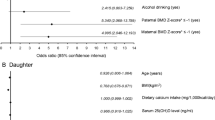Abstract
To estimate genetic effects on femoral neck geometry and the distribution of bone mineral within the proximal femur a cross-sectional twin analysis was carried out at a university hospital that compared correlations in these traits in pairs of mono- and dizygo-tic female twins. Monozygotic (MZ, n=51 pairs, age 49.1±9.3 years) and dizygotic (DZ, n=26 pairs, age 45.7±11.3 years) twins were randomly selected from a larger sample of twins previously studied. Measurements of bone mineral density (BMD), femoral neck angles and length, cross-sectional area and moment of interia, the center of mass of the narrowest cross-section of the femoral neck, and BMDs of regions within the femoral neck were made. A summary index of the resistance of the femoral neck to forces experienced in a fall with impact on the greater trochanter (Fall Index, FI) was calculated. MZ pair intraclass correlations (rMZ) were significantly (p<0.05) different from zero for all bone mass and femoral geometry variables (0.35<rMZ<0.82). DZ pair correlations (rDZ) were lower thanrMZ for all variables (0.04<rDZ<0.52) except femoral neck length (rDZ=0.38, rMZ=0.36). After adjustment for BMD of the femoral neck,rMZ was significantly greater thanrDZ, yielding high heritability estimates for regional BMDs (0.72<H 2<0.78), the center of mass of the femoral neck (H 2=0.70, −0.04 to 1.43 95% CI) and the resistance of the femoral neck to forces experienced in a fall (FI,H 2=0.94, 0.06 to 1.85 95% CI), but not for femoral neck length. Adjustments for age did not alter these findings. It is concluded that there are significant familial influences on the distribution of femoral bone mass and on the calculated structural strength of the proximal femur, but not on femoral neck length. If the assumptions of the twin model are correct, this is evidence for genetic factors influencing these traits.
Similar content being viewed by others
References
Smith DM, Nance WE, Kang KW, Christian JC, Johnston CC. Genetic factors in determining bone mass. J Clin Invest 1973;52:2800–8.
Pocock NA, Eisman JA, Hopper JL, Yeates MG, Sambrook PN, Ebert S. Genetic determinants of bone mass in adults: a twin study. J Clin Invest 1987;80:706–10.
Slemenda CW, Christian JC, Williams CJ, Norton JA, Johnston CC. Genetic determinants of bone mass in adult women: a reevaluation of the twin model and the potential importance of gene interaction on heritability estimates. J Bone Miner Res 1991;6:561–7.
Seeman E, Tsalamandris C, Formica C, Hopper JL, McKay J. Reduced femoral neck bone density in the daughters of women with hip fractures: the role of low peak bone density in the pathogenesis of osteoporosis. J Bone Miner Res 1994;9:739–44.
Cummings SR, Browner WS, Black DM, Fox K, Stone K, Ensrud K, Cauley J, Seeley D, Nevitt MC. Proceedings of the Fourth International Symposium on Osteoporosis. Handelstrykkeriet Aalborg ApS, 1993:73–4.
Faulkner KG, Cummings SR, Gluer CC, Palermo L, Black D, Genant HK, Simple measurement of femoral geometry predicts hip fracture: the study of osteoporotic fractures. 1993;8:1211–7.
Gluer C-C, Cummings SR, Pressman A, LI J, Gluer K, Faulkner KG, Grampp S, Genant HK. Prediction of hip fractures from pelvic radiographs: the study of osteoporotic fractures. J Bone Miner Res 1994;9:671–9.
Peacock M, Turner CH, Liu G, Manatunga AK, Timmerman L, Johnston CC, Better discrimination of hip fracture using bone density, geometry and architecture. Osteoporosis Int 1995;5:167–73.
Nakamura T, Turner CH, Yoshikawa T, Slemenda CW, Peacock M, Burr DB, Mizuno Y, Orimo H, Ouchi Y, Johnston CC. Do variations in hip geometry explain differences in hip fracture risk between Japanese and White Americans? J Bone Miner Res 1994;9:1071–6.
Yoshikawa T, Turner CH, Peacock M, Slemenda CW, Weaver CM, Teegarden T, Markwardt DT, Burr DB. Geometric structure of the femoral neck measured using dual energy x-ray absorptiometry. J Bone Miner Res 1994;9:1054–64.
Christian JC, Kang KW, Norton JA. Choice of an estimate of genetic variance from twin data. Am J Hum Genet 1974;26:154–61.
Slemenda CW, Christian JC, Reed TR, Reister TK, Williams CJ, Johnston CC. Long-term bone loss in men: effects of genetic and environmental factors. Ann Intern Med 1992;117:286–91.
Cummings SR, Black DM, Nevitt MC, Browner W, Cauley J, Ensrud K, Genant HK, Palermo L, Scott J, Vogt TM. Bone density at various sites for prediction of hip fractures: the study of osteoporotic fractures. Lancet 1993;341:72–5.
Ross PD, Davis JM, Epstein R, Wasnich RD. Pre-existing fractures and bone mass predict vertebral fracture incidence. Ann Intern Med 1991;114:919–23.
Author information
Authors and Affiliations
Rights and permissions
About this article
Cite this article
Slemenda, C.W., Turner, C.H., Peacock, M. et al. The genetics of proximal femur geometry, distribution of bone mass and bone mineral density. Osteoporosis Int 6, 178–182 (1996). https://doi.org/10.1007/BF01623944
Received:
Accepted:
Issue Date:
DOI: https://doi.org/10.1007/BF01623944




